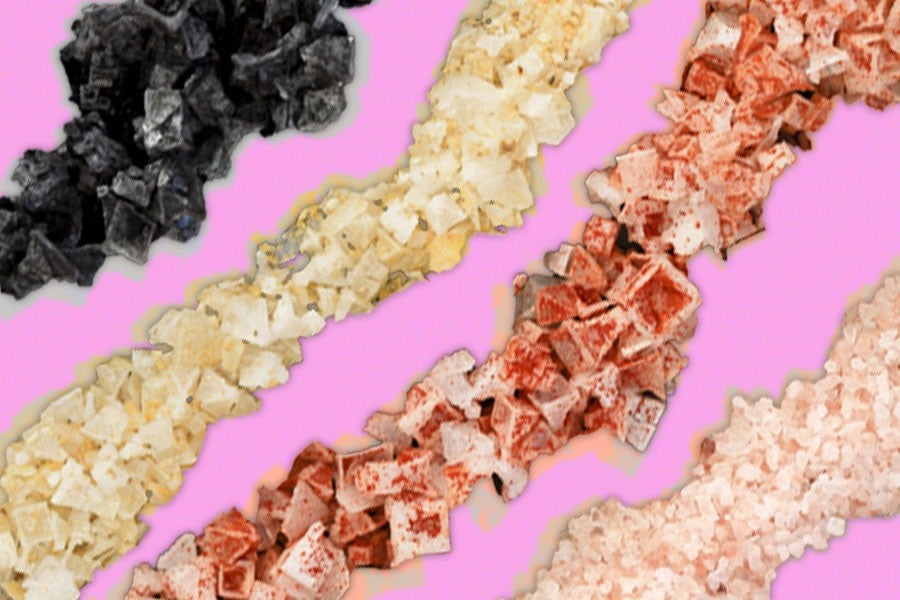When my editor approached me about listing an assortment of salts in order of how healthy they are (because it’s Friday the 13th and spilling salt is unlucky, get it?), I assumed that he’d accidentally dosed himself with an edible (again). I honestly believed that there was no possible way to meaningfully rank various types of salt by how good for us they are. As it turns out, my skepticism wasn’t totally unwarranted, reinforced as it was by the response I got after sending a lengthy list of salts to my go-to source for all nutritional queries.
“As a general rule, all of the salts listed below are around 98 percent sodium chloride,” Dana Hunnes, senior dietitian at the Ronald Reagan UCLA Medical Center, wrote in an email. “Therefore, any ‘health differences’ would come from other micronutrients that they contain other than sodium chloride (such as magnesium).”
In other words, there’s not too much to go on, because the actual differences between types of salt are essentially inconsequential. “It’s rather hard to rank them, because they’re so similar, and the two percent of other minerals in them doesn’t really add much to the typical diet,” Hunnes explains. In larger amounts, though, these trace minerals can help the body carry out its daily functions and processes in the most efficient way possible.
It’s worth noting that sodium chloride is an essential compound that the body uses to absorb and transport nutrients, stabilize blood pressure, maintain the right fluid balance and so on. But too much sodium chloride has been linked to high blood pressure, as well as increased risk for heart disease and kidney disease. “Your average healthy individual should aim for less than 2,400 milligrams of sodium per day [approximately one teaspoon], and if you’re salt-sensitive, you should aim for less than 1,500 milligrams per day [less than one teaspoon],” Hunnes says. Not to mention: “Anyone with heart disease or kidney disease should really stay away from all of the salts listed below.”
But back to the ranking of salts: I refused to give up on my mission, so Hunnes entertained this silly idea to the best of her abilities.
Here’s the ranking that she came up with…
1. Himalayan Pink Salt and Kala Namak (tied): These two Himalayan salts seem like obvious winners, since we’re going by how many nutrients they contain other than sodium chloride. Himalayan pink salt contains trace amounts of 84 minerals — including boron (which improves bone health), chromium (which improves heart health), copper (which improves energy production), fluoride (which, like boron, improves bone health), iodine (which improves thyroid health), selenium (which reduces the risk of certain cancers) and zinc (which boosts the immune system) — while Kala Namak (a black salt) contains higher amounts of potassium (which supports cardiovascular health) and calcium (which improves bone health) than your average table salt.
3. Black Hawaiian Salt: Because black salts (like Kala Namak) tend to be higher in minerals like potassium and calcium, black Hawaiian salt earns second place on this list. Black Hawaiian salt also benefits from the addition of activated charcoal, which may promote kidney function and reduce cholesterol.
4. Fleur De Sel: Translated to “flower of salt,” this paper-thin salt is hand-harvested from tidal pools off the coast of France. Fleur de Sel is also relatively high in zinc, potassium, iron (which supports the circulatory system), calcium and magnesium (which can fight depression) as a result of its oceanic beginnings.
5. Celtic Sea Salt: Also harvested from tidal ponds off the coast of France, Celtic sea salt benefits from the mineral-rich seawater it’s extracted from.
6. Sea Salt: While “sea salt” is a blanket term — as it includes the specialty sea salts listed above — your average sea salt is probably slightly less nutrient dense than Fleur de Sel and Celtic sea salt.
7. Flake Salt: This is yet another sea salt; however, it’s typically extracted by means of evaporation or boiling, which reduces its mineral content.
8. Kosher Salt: Kosher salt is a coarser version of table salt that’s less likely to contain additives like anti-caking agents and iodine (often added to salt to prevent iodine deficiency, a common cause of hypothyroidism). Its name comes from the fact that the size of the salt crystals is ideal for drawing moisture out of meat, making it perfect for the process of koshering (that is, using salt to extract blood from the meat before serving).
9. Table Salt: Table salt is farmed from either rock salt or brine (water saturated with salt), then heavily ground so that most of the impurities and trace minerals are removed. After that, anti-caking agents and iodine are added to the mix.
10. Pickling Salt: Used for pickling — hence the name — pickling salt doesn’t contain added iodine or anti-caking agents. It also doesn’t contain many of those trace minerals found in sea salts, which can cause the discoloration of preserved foods. Some minerals have a distinct color that seeps into foods during the pickling process, while others experience color changes when exposed to light, heat and certain other substances.
So… I guess you can rank salt types by health. I’ll never accuse my editor of being high again. (I will totally accuse my editor of being high again.)

